Housing and the City: A Spatial Analysis of Residential Building Activity and the Socio-Demographic Background in a Mediterranean City, 1990–2017
Abstract
1. Introduction
2. Methodology
2.1. Study Area
2.2. Elementary Building Permit Data
2.3. Building Activity Indicators
2.4. Background Indicators
2.5. Data Analysis
2.5.1. Hierarchical Clustering
2.5.2. K-Means Clustering
2.5.3. Non-Parametric Correlations and Two-Way Joining
3. Results
3.1. Descriptive Analysis
3.2. Hierarchical Clustering of Indicators and Locations
3.3. Market Segmentation Using a K-Means Clustering Strategy
3.4. Non-Parametric Correlation Analysis of Background Local Contexts
4. Discussion
5. Conclusions
Author Contributions
Funding
Conflicts of Interest
References
- Coiacetto, E. Real estate development industry structure: Consequences for urban planning and development. Plan. Pract. Res. 2006, 21, 423–441. [Google Scholar] [CrossRef]
- Barras, R. Building Cycles: Growth and Instability; Wiley: London, UK, 2009. [Google Scholar]
- Balta, M.O.; Eke, F. Spatial Reflection of Urban Planning in Metropolitan Areas and Urban Rent: A Case Study of Cayyolu, Ankara. Eur. Plan. Stud. 2011, 19, 1817–1838. [Google Scholar] [CrossRef]
- Barr, J.; Cohen, J.P. The floor area ratio gradient: New York City, 1890–2009. Reg. Sci. Urban Econ. 2014, 48, 110–119. [Google Scholar] [CrossRef]
- Wu, F. Simulating temporal fluctuations of real estate development in a cellular automata city. Trans. Gis 2003, 7, 193–210. [Google Scholar] [CrossRef]
- Arbaci, S. Ethnic segregation, housing systems and welfare regimes. Eur. J. Hous. Policy 2007, 7, 401–433. [Google Scholar] [CrossRef]
- Aalbers, M.B. Geographies of housing finance: The mortgage market in Milan, Italy. Growth Chang. 2007, 38, 174–199. [Google Scholar] [CrossRef]
- Weber, R. Selling city futures: The financialization of urban redevelopment policy. Econ. Geogr. 2010, 86, 251–274. [Google Scholar] [CrossRef]
- Whitehead, C.; Williams, P. Causes and Consequences? Exploring the Shape and Direction of the Housing System in the UK Post the Financial Crisis. Hous. Stud. 2011, 26, 1157–1169. [Google Scholar] [CrossRef]
- Diappi, L. Emergent Phenomena in Housing Markets. Gentrification, Housing Search, Polarization; Springer: Berlin, Germany, 2013. [Google Scholar]
- Beauregard, R.A. The textures of property markets: Downtown housing and office conversions in New York City. Urban Stud. 2005, 42, 2431–2445. [Google Scholar] [CrossRef]
- Malheiros, J. Ethni-cities: Residential Patterns in the Northern European and Mediterranean Metropolises—Implications for Policy Design. Int. J. Popul. Geogr. 2002, 8, 107–134. [Google Scholar] [CrossRef]
- Schneider, A.; Woodcock, C.E. Compact, dispersed, fragmented, extensive? A comparison of urban growth in twenty-five global cities using remotely sensed data, pattern metrics and census information. Urban Stud. 2008, 45, 659–692. [Google Scholar] [CrossRef]
- European Environment Agency. Mapping Guide for a European Urban Atlas; EEA: Copenhagen, Denmark, 2011. [Google Scholar]
- Pili, S.; Grigoriadis, E.; Carlucci, M.; Clemente, M.; Salvati, L. Towards Sustainable Growth? A Multi-criteria Assessment of (Changing) Urban Forms. Ecol. Indic. 2017, 76, 71–80. [Google Scholar] [CrossRef]
- Andreotti, A.; Garcia, S.M.; Gomez, A.; Hespanha, P.; Kazepov, Y.; Mingione, E. Does a Southern European model exist? J. Eur. Area Stud. 2001, 9, 43–62. [Google Scholar] [CrossRef]
- Arbaci, S. (Re)Viewing Ethnic Residential Segregation in Southern European Cities: Housing and Urban Regimes as Mechanisms of Marginalisation. Hous. Stud. 2008, 23, 589–613. [Google Scholar] [CrossRef]
- Couch, C.; Petschel-held, G.; Leontidou, L. Urban Sprawl in Europe: Landscapes, Land-Use Change and Policy; Blackwell: London, UK, 2007. [Google Scholar]
- Giannakourou, G. Transforming spatial planning policy in Mediterranean countries: Europeanization and domestic change. Eur. Plan. Stud. 2005, 13, 319–331. [Google Scholar] [CrossRef]
- Castles, F.G.; Ferrera, M. Home ownership and welfare: Is southern Europe different? South Eur. Soc. Politics 1996, 1, 163–185. [Google Scholar] [CrossRef]
- Maloutas, T. Socio-Economic Classification Models and Contextual Difference: The ‘European Socio-economic Classes’ (ESeC) from a South European Angle. South Eur. Soc. Politics 2007, 12, 443–460. [Google Scholar] [CrossRef]
- Arapoglou, V.P.; Sayas, J. New facets of urban segregation in southern Europe. Eur. Urban Reg. Stud. 2009, 16, 345–362. [Google Scholar] [CrossRef]
- Allen, J.; Barlow, J.; Leal, J.; Maloutas, T.; Padovani, L. Housing and Welfare in Southern Europe; Wiley: London, UK, 2004. [Google Scholar]
- Burgel, G. Athènes, de la balkanisation à la mondialisation. Méditerranée 2004, 103, 59–63. [Google Scholar] [CrossRef]
- Costa, F.J.; Noble, A.G.; Pendeleton, G. Evolving planning systems in Madrid, Rome, and Athens. Geojournal 1991, 24, 293–303. [Google Scholar] [CrossRef]
- Fekade, W. Deficits of formal urban land management and informal responses under rapid urban growth, an international perspective. Habitat Int. 2000, 24, 127–150. [Google Scholar] [CrossRef]
- Leontidou, L. The Mediterranean City in Transition; Cambridge University Press: Cambridge, UK, 1990. [Google Scholar]
- Ferrara, A.; Salvati, L.; Sabbi, A.; Colantoni, A. Soil resources, land cover changes and rural areas: Towards a spatial mismatch? Sci. Total Environ. 2014, 478, 116–122. [Google Scholar] [CrossRef] [PubMed]
- Mayer, C.J.; Somerville, C.T. Land use regulation and new construction. Reg. Sci. Urban Econ. 2000, 30, 639–662. [Google Scholar] [CrossRef]
- Garcia, D.; Riera, P. Expansion versus density in Barcelona: A valuation exercise. Urban Stud. 2003, 40, 1925–1936. [Google Scholar] [CrossRef]
- Salvati, L. From Sprawl to Compactness and Back: Long-term Population Dynamics (1848–2011) and the Economic Structure of a Mediterranean city. Geojournal 2016, 81, 319–332. [Google Scholar] [CrossRef]
- Taltavull de La Paz, P.; Gabrielli, L. Housing Supply and Price Reactions: A Comparison Approach to Spanish and Italian Markets. Hous. Stud. 2014. [Google Scholar] [CrossRef]
- Chorianopoulos, I.; Pagonis, T.; Koukoulas, S.; Drymoniti, S. Planning, competitiveness and sprawl in the Mediterranean city: The case of Athens. Cities 2010, 27, 249–259. [Google Scholar] [CrossRef]
- Polyzos, S.; Minetos, D. Informal housing in Greece: A multinomial logistic regression analysis at the regional level. Eur. Spat. Res. Policy 2013, 20, 57–85. [Google Scholar] [CrossRef]
- Rontos, K.; Grigoriadis, S.; Sateriano, A.; Syrmali, M.; Vavouras, I.; Salvati, L. Lost in Protest, Found in Segregation: Divided Cities in the Light of the 2015 ‘Oki’ Referendum in Greece. City Cult. Soc. 2016, 7, 139–148. [Google Scholar] [CrossRef]
- Li, M.; Ye, X.; Zhang, S.; Tang, X.; Shen, Z. A framework of comparative urban trajectory analysis. Environ. Plan. B Urban Anal. City Sci. 2018, 45, 489–507. [Google Scholar] [CrossRef]
- Kloosterman, R.C.; Lambregts, B. Between accumulation and concentration of capital: Toward a framework for comparing long-term trajectories of urban systems. Urban Geogr. 2007, 28, 54–73. [Google Scholar] [CrossRef]
- Salvati, L.; Zitti, M.; Sateriano, A. Changes in the City Vertical Profile as an Indicator of Sprawl: Evidence from a Mediterranean Region. Habitat Int. 2013, 38, 119–125. [Google Scholar] [CrossRef]
- Salvati, L.; Sateriano, A.; Grigoriadis, S. Crisis and the City: Profiling Urban Growth under Economic Expansion and Stagnation. Lett. Spat. Resour. Sci. 2016, 9, 329–342. [Google Scholar] [CrossRef]
- Napoli, G.; Giuffrida, S.; Trovato, M.R.; Valenti, A. Cap rate as the interpretative variable of the urban real estate capital asset: A comparison of different sub-market definitions in Palermo, Italy. Buildings 2017, 7, 80. [Google Scholar] [CrossRef]
- Ciuna, M.; Salvo, M.; Simonotti, M. Multilevel methodology approach for the construction of real estate monthly index numbers. J. Real Estate Lit. 2014, 22, 281–302. [Google Scholar]
- Barreca, A.; Curto, R.; Rolando, D. Assessing Social and Territorial Vulnerability on Real Estate Submarkets. Buildings 2017, 7, 94. [Google Scholar] [CrossRef]
- Del Giudice, V.; De Paola, P. Real Estate Economics, Management and Investments: New Perspectives and Frontiers. Buildings 2018, 8, 40. [Google Scholar] [CrossRef]
- Del Giudice, V. Estimo e Valutazione Economica dei Progetti; Loffredo Iniziative Editorial: Milan, Italy, 2010. [Google Scholar]
- Gabrielli, L.; Giuffrida, S.; Trovato, M.R. From Surface to Core: A Multi-layer Approach for the Real Estate Market Analysis of a Central Area in Catania. In Computational Science and Its Applications—ICCSA 2015; Gervasi, O., Murgante, B., Misra, S., Gavrilova, M.L., Rocha, A.M.A.C., Torre, C.M., Taniar, D., Apduhan, B.O., Eds.; Springer: Berlin, Germany, 2015; Volume 3, pp. 284–300. [Google Scholar]
- Gabrielli, L. Cluster Analysis and Italian Real Estate Market Analysis during the Downturn. In Proceedings of the 20th Annual European Real Estate Society Conference, Vienna, Austria, 3–6 July 2013. [Google Scholar]
- Valenti, A.; Giuffrida, S.; Linguanti, F. Decision Trees Analysis in a Low-Tension Real Estate Market: The Case of Troina (Italy). In Computational Science and Its Applications—ICCSA 2015; Gervasi, O., Murgante, B., Misra, S., Gavrilova, M.L., Rocha, A.M.A.C., Torre, C.M., Taniar, D., Apduhan, B.O., Eds.; Springer: Berlin, Germany, 2015; Volume 3, pp. 237–252. [Google Scholar]
- Chan, L.; Ng, H.T.; Ramchand, R. A Cluster Analysis Approach to Examining Singapore’s Property Market. In Property Markets and Financial Stability; BIS Papers; Bank for International Settlements: Basel, Switzerland, 2012; Volume 64, pp. 43–53. [Google Scholar]
- Hepşen, A.; Vatansever, M. Using Hierarchical Clustering Algorithms for Turkish Residential Market. Int. J. Econ. Financ. 2012, 4, 138–150. [Google Scholar]
- Arbaci, S.; Malheiros, J. De-Segregation, Peripheralisation and the Social Exclusion of Immigrants: Southern European Cities in the 1990s. J. Ethn. Migr. Stud. 2010, 36, 227–255. [Google Scholar] [CrossRef]
- Le Goix, R. Gated Communities: Sprawl and Social Segregation in Southern California. Hous. Stud. 2005, 20, 323–343. [Google Scholar] [CrossRef]
- Jiménez, F. Building Boom and Political Corruption in Spain. South Eur. Soc. Politics 2009, 14, 255–272. [Google Scholar] [CrossRef]
- Salvati, L.; Serra, P. Estimating rapidity of change in complex urban systems: A multidimensional, local-scale approach. Geogr. Anal. 2016, 48, 132–156. [Google Scholar] [CrossRef]
- Guy, S.; Henneberry, J. Bridging the divide? Complementary perspectives on property. Urban Stud. 2002, 39, 1471–1478. [Google Scholar] [CrossRef]
- Zambon, I.; Colantoni, A.; Carlucci, M.; Morrow, N.; Sateriano, A.; Salvati, L. Land quality, sustainable development and environmental degradation in agricultural districts: A computational approach based on entropy indexes. Environ. Impact Assess. Rev. 2017, 64, 37–46. [Google Scholar] [CrossRef]
- Temelová, J.; Novák, J.; Ouředníček, M.; Puldová, P. Housing estates in the Czech Republic after socialism: Various trajectories and inner differentiation. Urban Stud. 2011, 48, 1811–1834. [Google Scholar] [CrossRef]
- Kabisch, N.; Haase, D. Diversifying European agglomerations: Evidence of urban population trends for the 21st century. Popul. Space Place 2011, 17, 236–253. [Google Scholar] [CrossRef]
- Kuang, W.; Liu, J.; Dong, J.; Chi, W.; Zhang, C. The rapid and massive urban and industrial land expansions in China between 1990 and 2010: A CLUD-based analysis of their trajectories, patterns, and drivers. Landsc. Urban Plan. 2016, 145, 21–33. [Google Scholar] [CrossRef]
- Morelli, V.G.; Rontos, K.; Salvati, L. Between suburbanisation and re-urbanisation: Revisiting the urban life cycle in a Mediterranean compact city. Urban Res. Pract. 2014, 7, 74–88. [Google Scholar] [CrossRef]
- Di Feliciantonio, C.; Salvati, L. ‘Southern’Alternatives of Urban Diffusion: Investigating Settlement Characteristics and Socio-Economic Patterns in Three M editerranean Regions. Tijdschrift Voor Economische En Sociale Geografie 2015, 106, 453–470. [Google Scholar] [CrossRef]
- Zambon, I.; Serra, P.; Sauri, D.; Carlucci, M.; Salvati, L. Beyond the ‘Mediterranean city’: Socioeconomic disparities and urban sprawl in three Southern European cities. Geogr. Ann. Ser. B Hum. Geogr. 2017, 99, 319–337. [Google Scholar] [CrossRef]
- Ramalho, C.E.; Hobbs, R.J. Time for a change: Dynamic urban ecology. Trends Ecol. Evol. 2011, 27, 179–188. [Google Scholar] [CrossRef] [PubMed]
- Monarca, D.; Colantoni, A.; Cecchini, M.; Longo, L.; Vecchione, L.; Carlini, M.; Manzo, A. Energy characterization and gasification of biomass derived by hazelnut cultivation: Analysis of produced syngas by gas chromatography. Math. Probl. Eng. 2012, 2012, 102914. [Google Scholar] [CrossRef]
- Di Giacinto, S.; Colantoni, A.; Cecchini, M.; Monarca, D.; Moscetti, R.; Massantini, R. Dairy production in restricted environment and safety for the workers. Ind. Aliment. 2012, 530, 5–12. [Google Scholar]
- Colantoni, A.; Cecchini, M.; Monarca, D.; Bedini, R.; Riccioni, S. The risk of musculoskeletal disorders due to repetitive movements of upper limbs for workers employed in hazelnut sorting. J. Agric. Eng. 2013, 44. [Google Scholar] [CrossRef]
- Monarca, D.; Cecchini, M.; Guerrieri, M.; Colantoni, A. Conventional and alternative use of biomasses derived by hazelnut cultivation and processing. Acta Hortic. 2008, 845, 627–634. [Google Scholar] [CrossRef]
- Delfanti, L.; Colantoni, A.; Recanatesi, F.; Bencardino, M.; Sateriano, A.; Zambon, I.; Salvati, L. Solar plants, environmental degradation and local socioeconomic contexts: A case study in a Mediterranean country. Environ. Impact Assess. Rev. 2016, 61, 88–93. [Google Scholar] [CrossRef]
- Marucci, A.; Zambon, I.; Colantoni, A.; Monarca, D. A combination of agricultural and energy purposes: Evaluation of a prototype of photovoltaic greenhouse tunnel. Renew. Sustain. Energy Rev. 2018, 82, 1178–1186. [Google Scholar] [CrossRef]
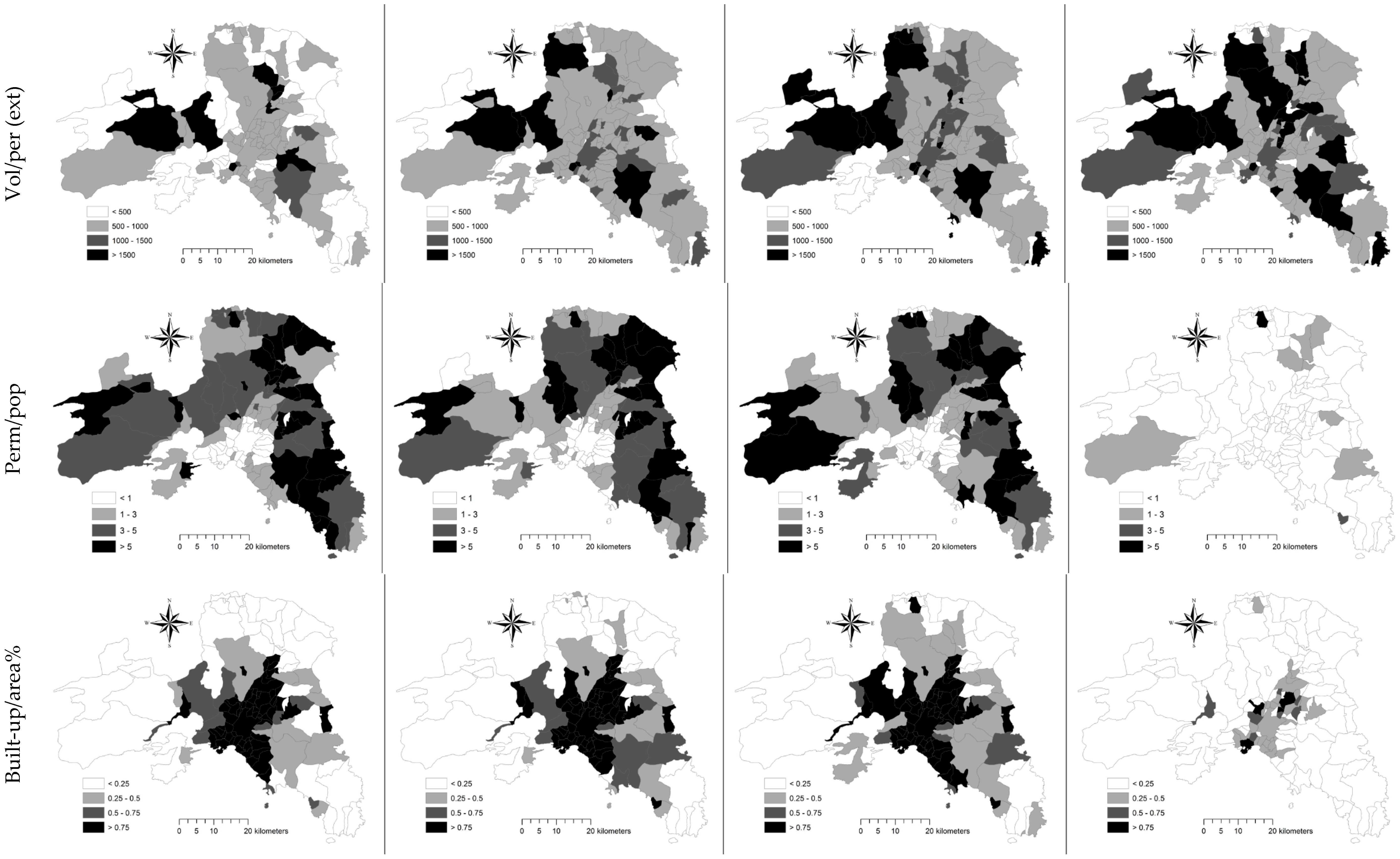

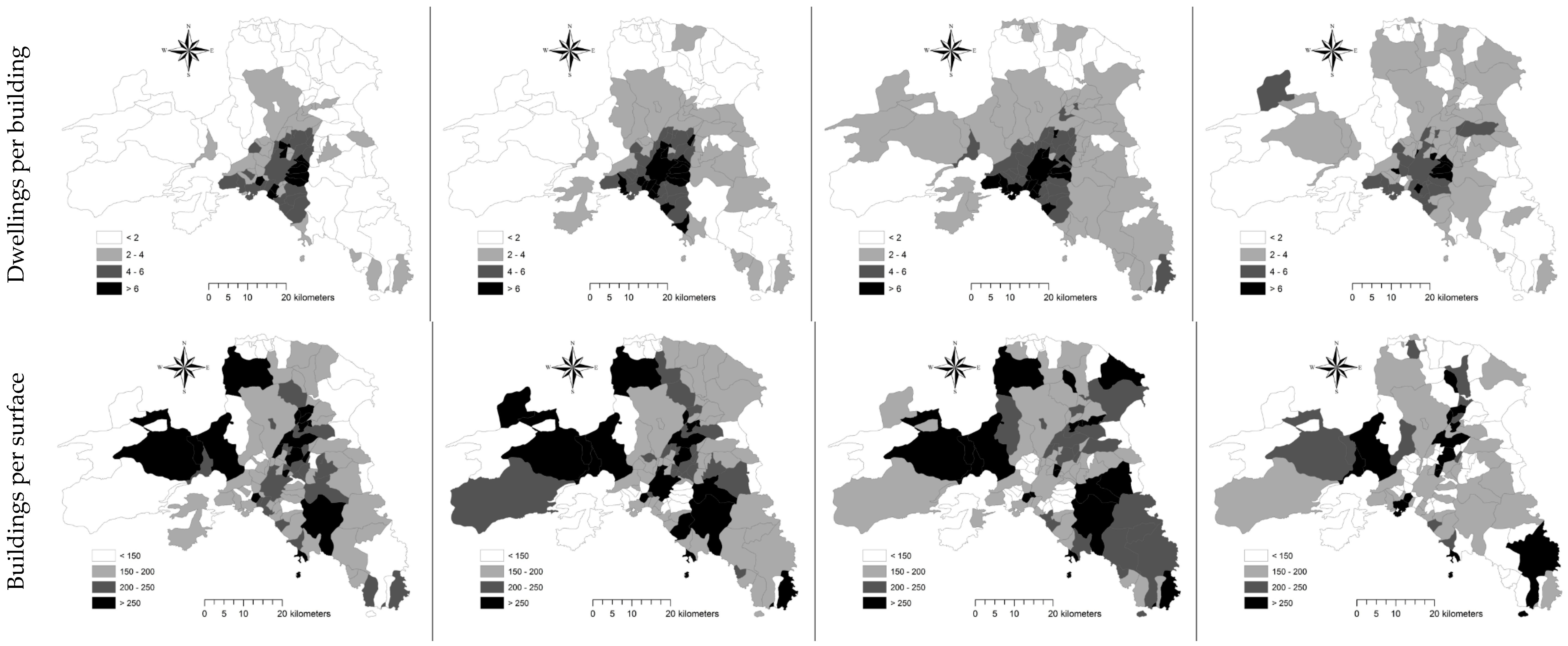
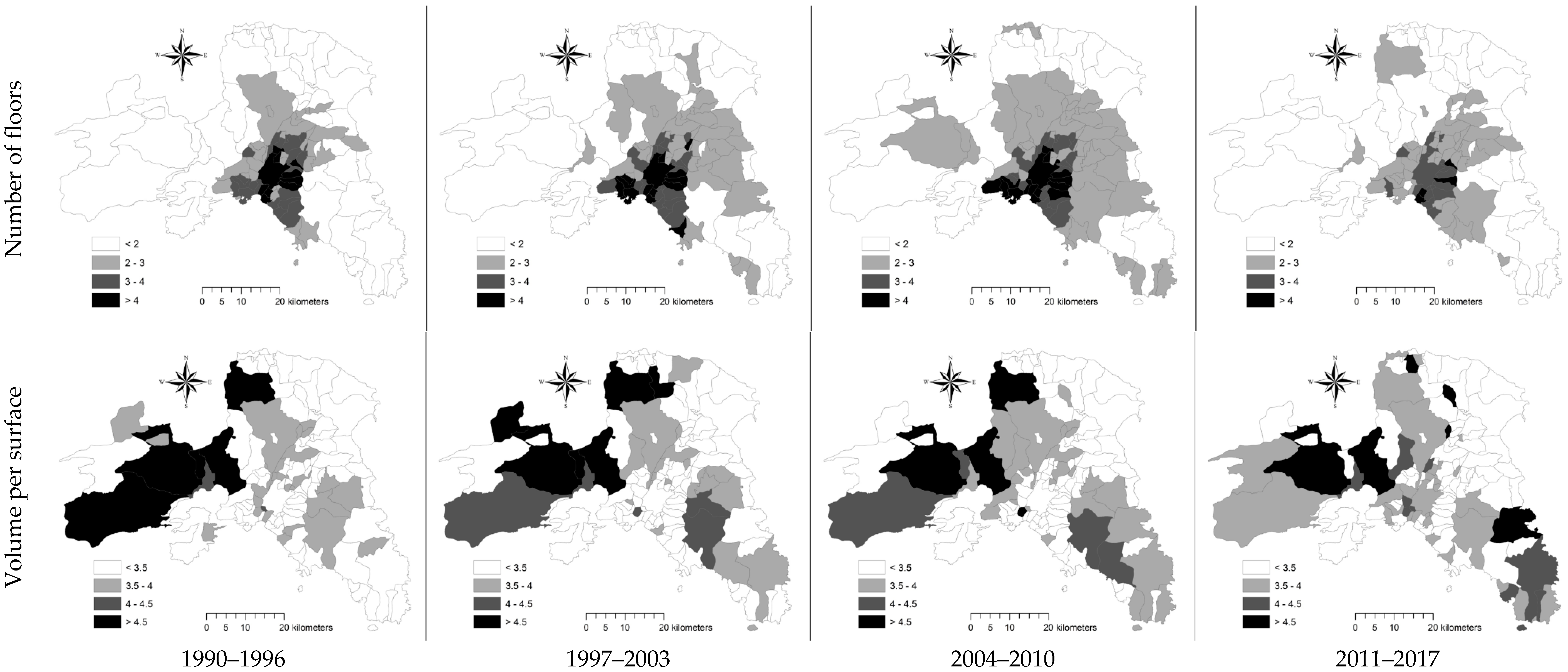

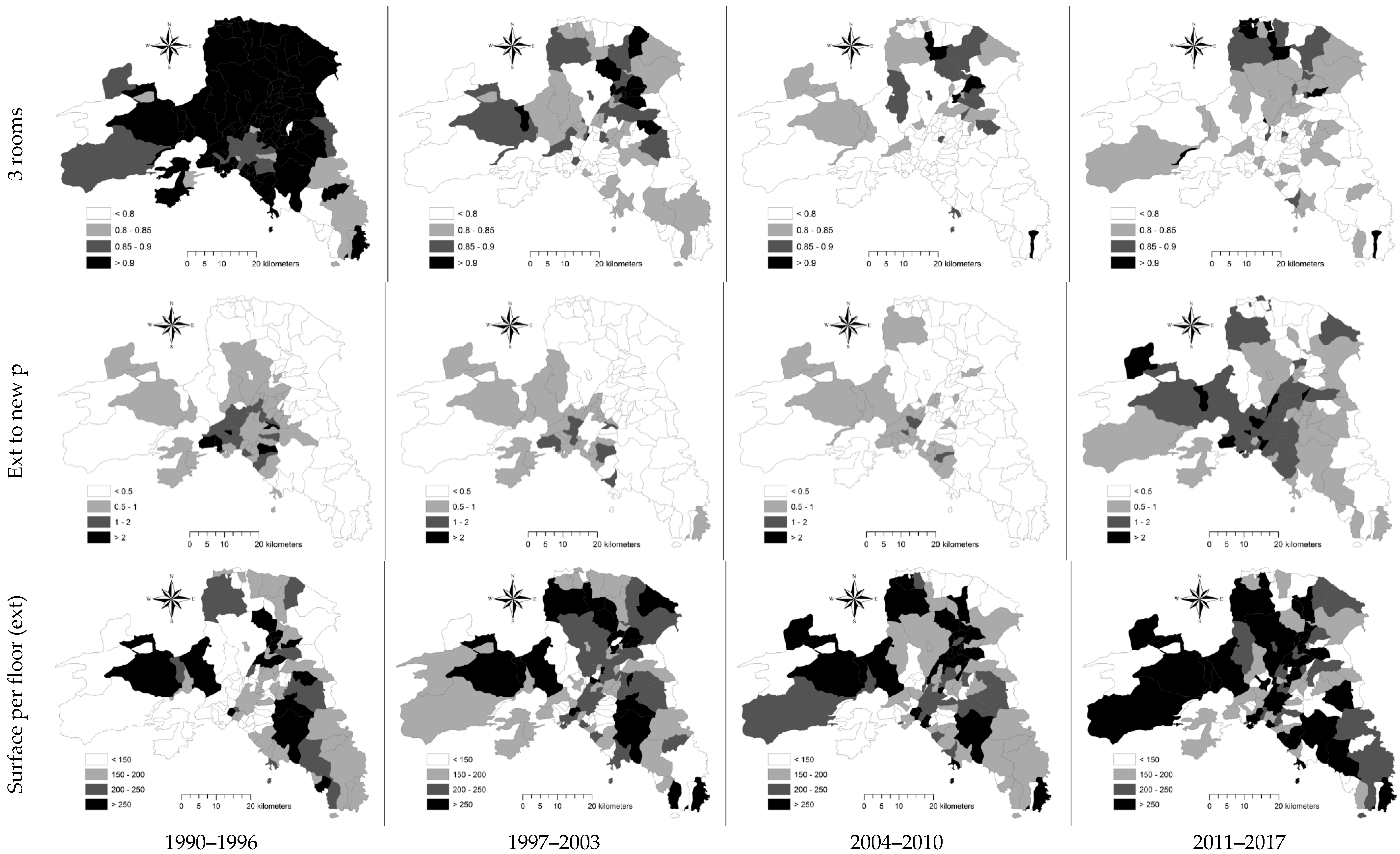
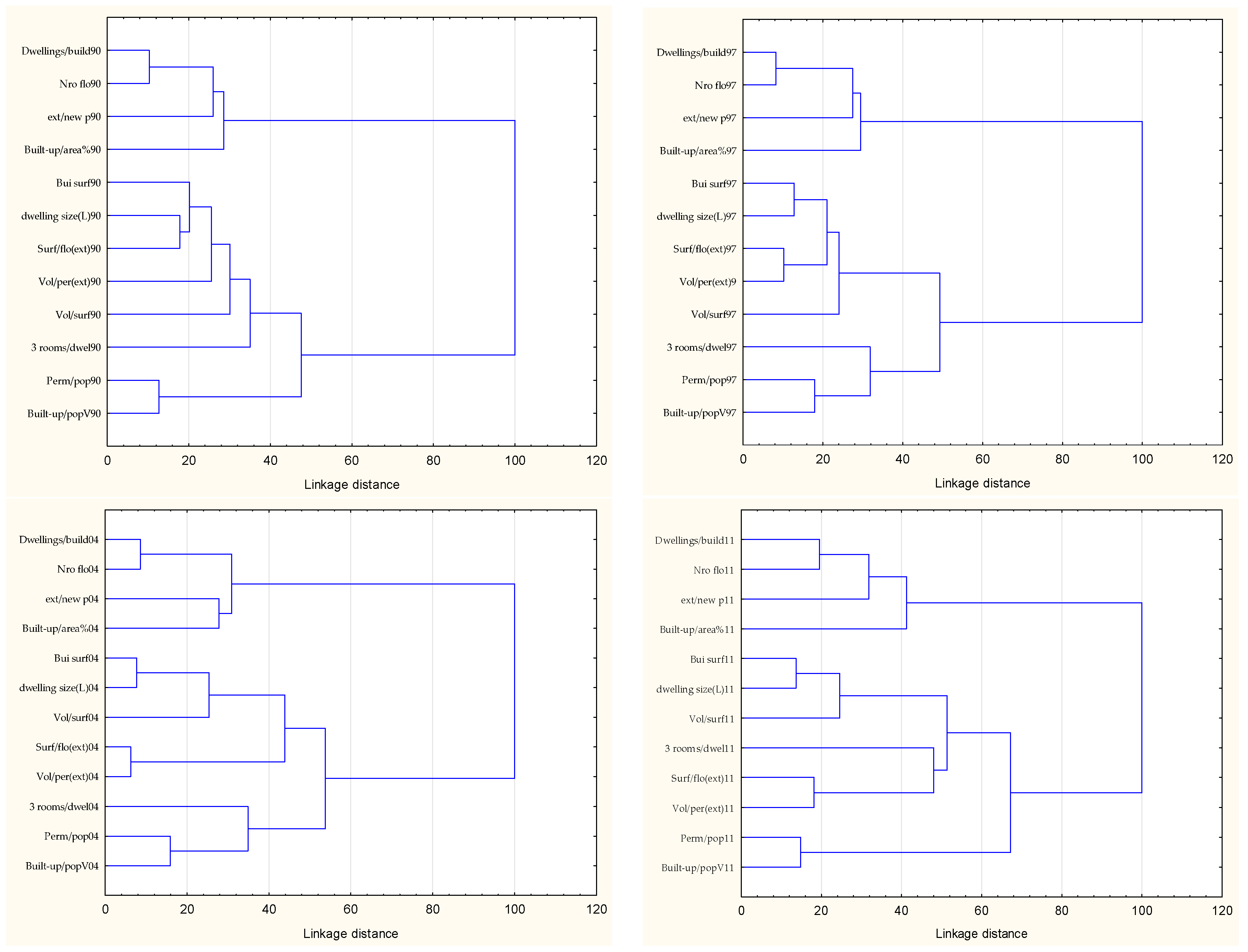

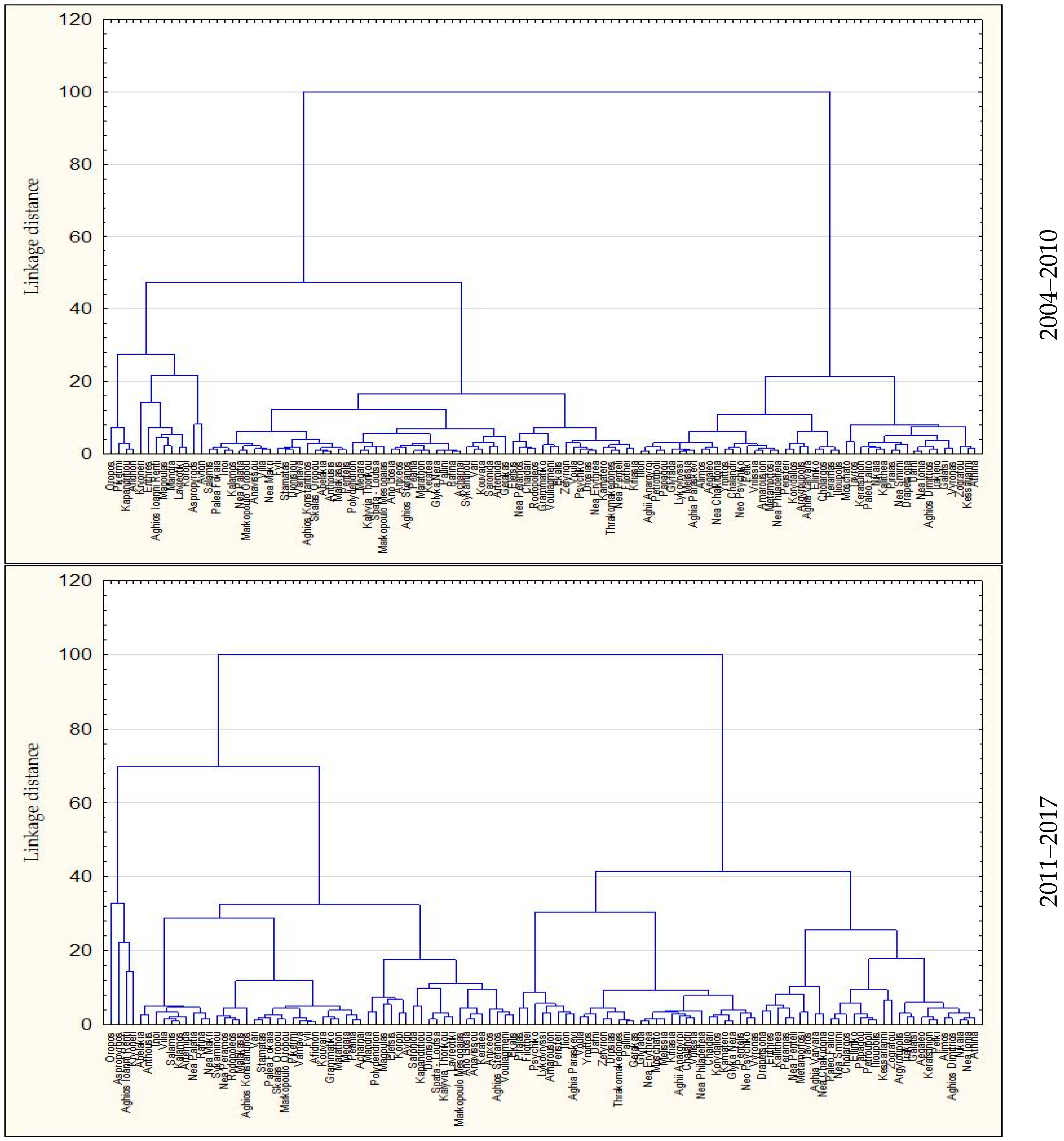
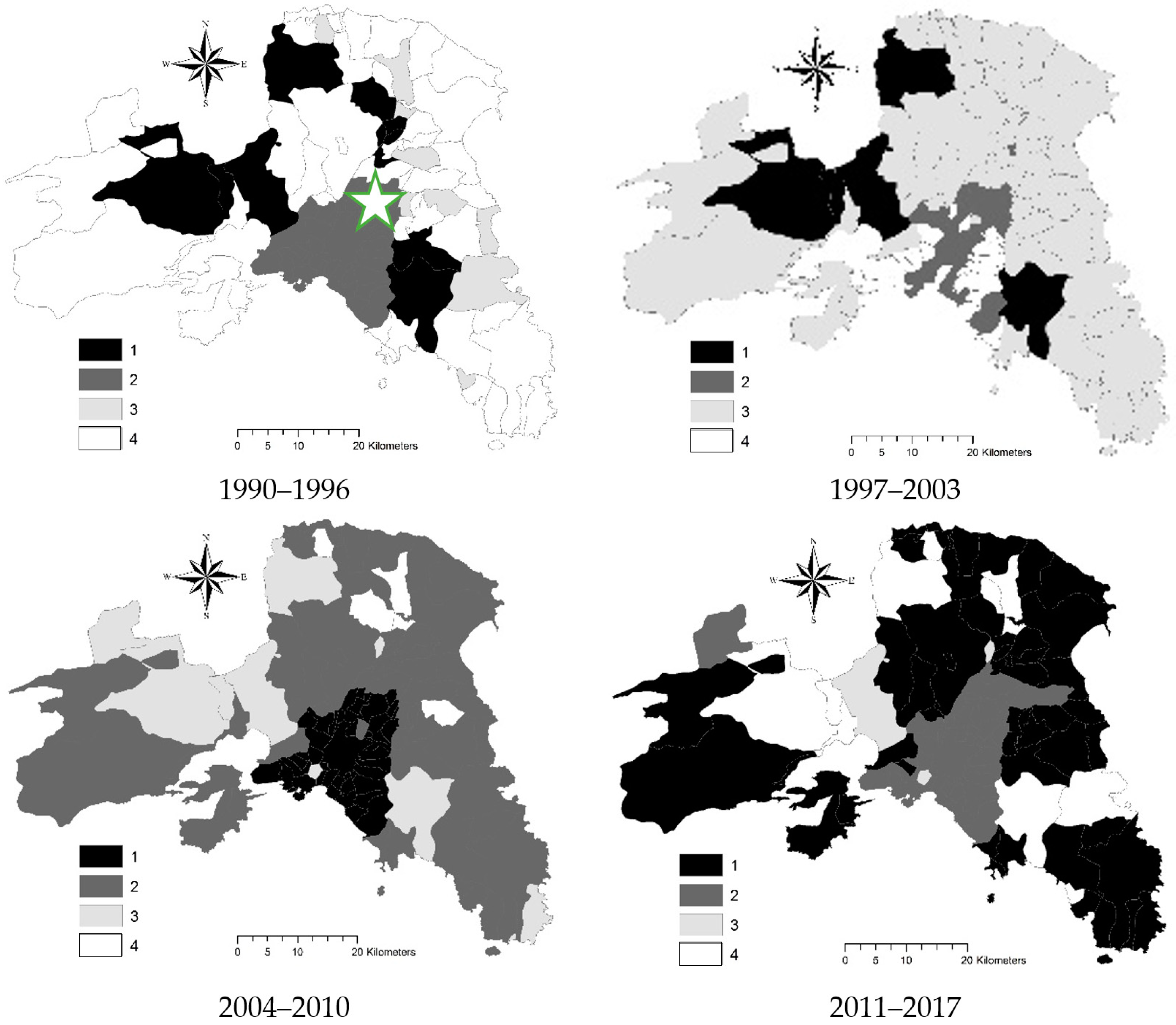
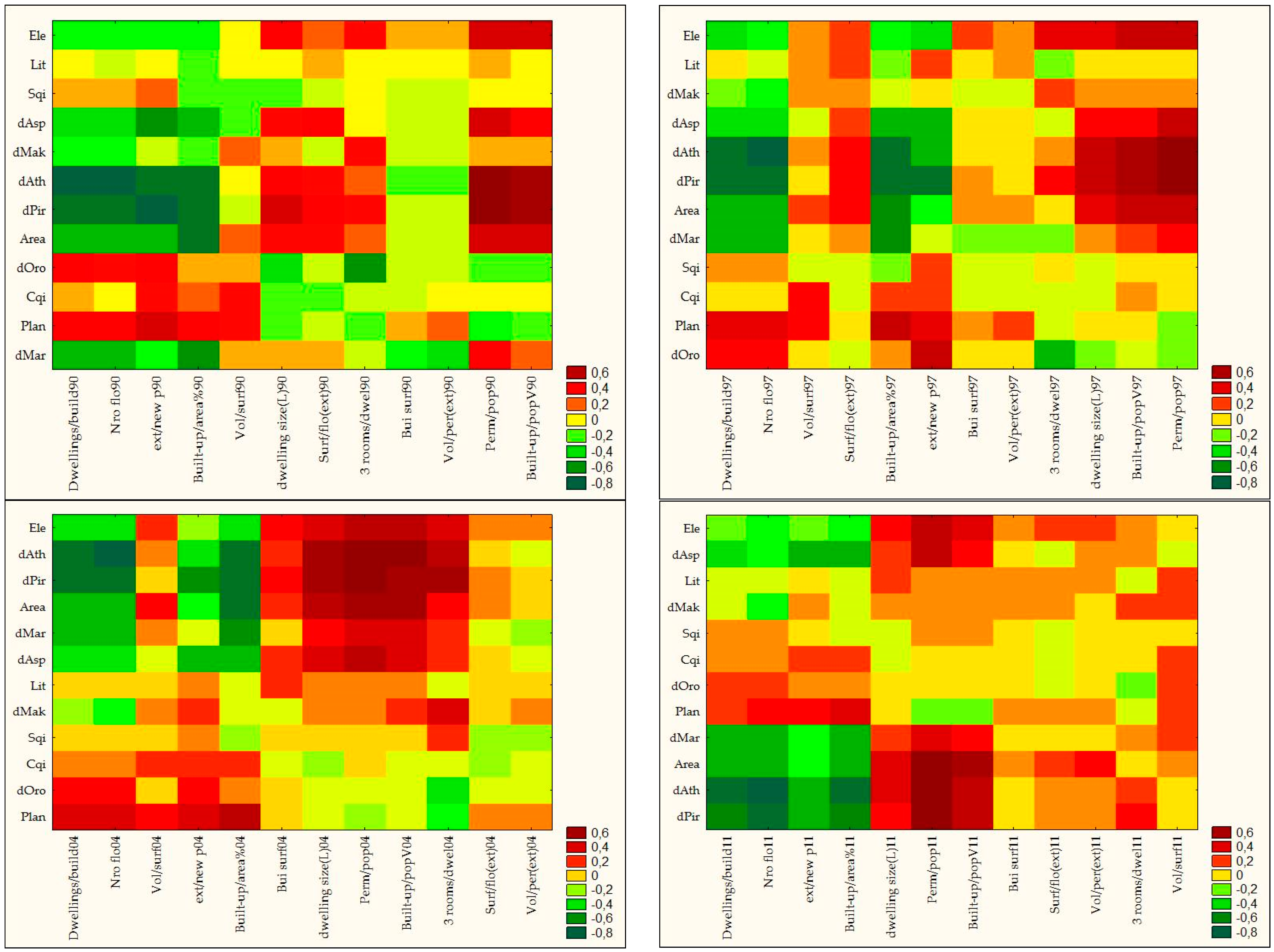
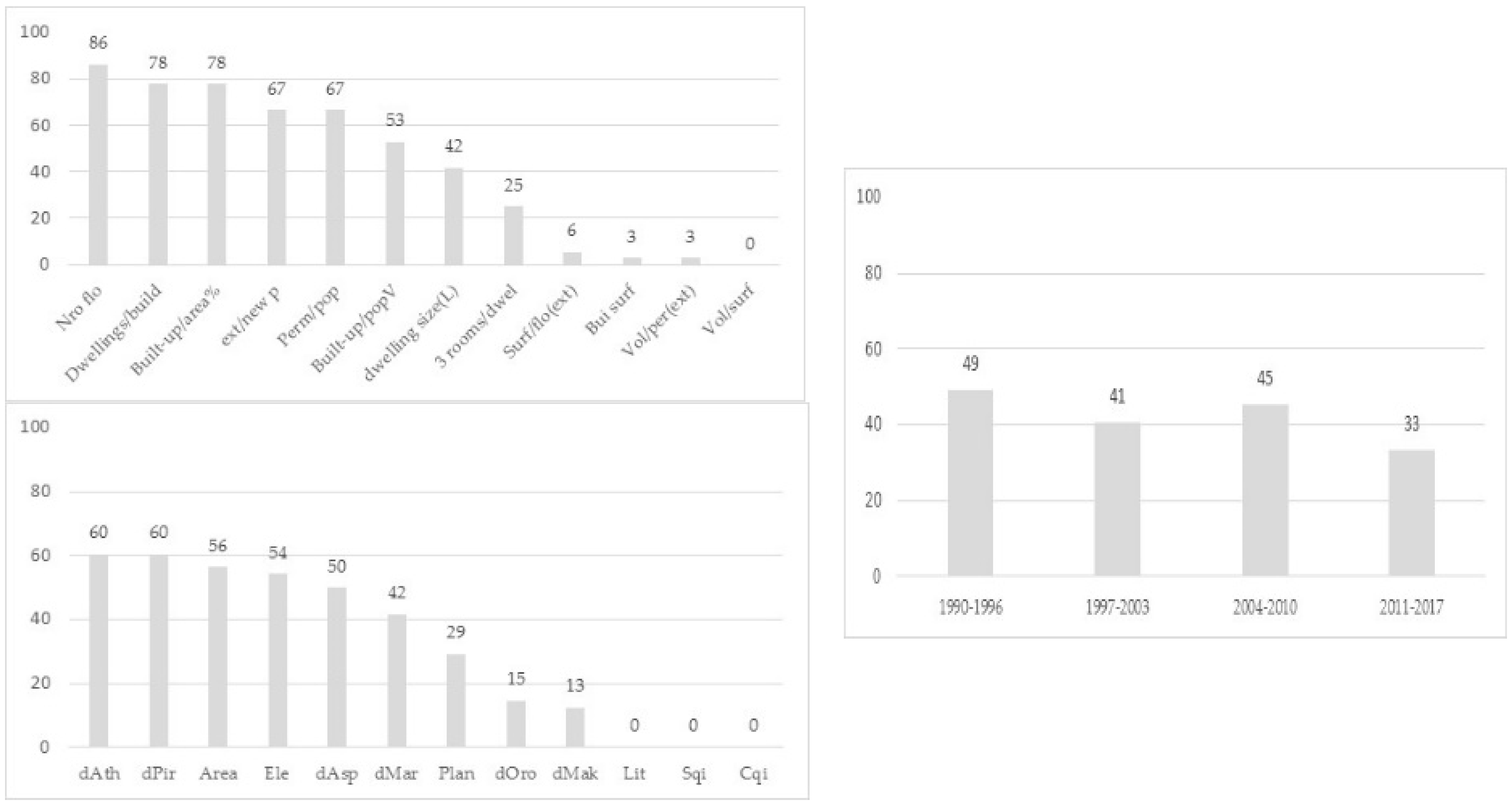
| Description | Acronym | Unit |
|---|---|---|
| Average number of floors (new buildings) | avg_flo_new | |
| Average number of floors (building additions) | avg_flo_ext | |
| Average surface area of new buildings | avg_sur_new | m2 |
| Average surface area of building additions | avg_sur_ext | m2 |
| Authorized dwellings >2 rooms in total dwellings | dwel3+ | % |
| Number of new dwellings per 1000 inhabitants | dwel_pop | |
| New building permits in the total stock of released permits | new_pe% | |
| Ratio of additions-to-new buildings volume | vol_ext_new | |
| Surface of new building permits in total urban area | sur_new_urb | % |
| Surface of building additions in total urban area | sur_ext_urb | % |
| Density of permits released for new buildings | pe_new_sup | Build/km2 |
| Density of permits released for building additions | pe_ext_sup | Build/km2 |
| Variable | Cluster 1 | Cluster 2 | Cluster 3 | Cluster 4 | ||||
|---|---|---|---|---|---|---|---|---|
| Mean | SD | Mean | SD | Mean | SD | Mean | SD | |
| 1990–1996 | ||||||||
| Dwellings/build | −0.86 | 0.21 | 0.96 | 0.80 | −0.78 | 0.22 | −0.66 | 0.29 |
| Bui surf | 1.58 | 1.47 | 0.03 | 0.88 | −0.41 | 0.49 | −0.33 | 0.66 |
| Nro flo | −0.79 | 0.27 | 0.94 | 0.83 | −0.69 | 0.22 | −0.67 | 0.33 |
| Vol/surf | 1.55 | 1.93 | −0.18 | 0.35 | −0.46 | 0.23 | −0.10 | 0.94 |
| dwelling size(L) | 2.08 | 2.01 | −0.46 | 0.37 | 0.17 | 0.54 | −0.04 | 0.39 |
| 3 rooms/dwel | 0.87 | 0.60 | −0.25 | 0.53 | 0.04 | 1.15 | 0.05 | 1.29 |
| ext/new p | −0.55 | 0.24 | 0.75 | 1.14 | −0.76 | 0.15 | −0.52 | 0.25 |
| Surf/flo(ext) | 2.29 | 1.62 | −0.37 | 0.44 | −0.04 | 0.53 | −0.14 | 0.49 |
| Vol/per(ext) | 2.20 | 2.06 | −0.13 | 0.40 | −0.22 | 0.36 | −0.34 | 0.24 |
| Perm/pop | 0.57 | 0.91 | −0.59 | 0.15 | 2.52 | 1.93 | 0.06 | 0.38 |
| Built-up/area% | −0.35 | 0.75 | 0.81 | 0.82 | −0.55 | 0.55 | −0.67 | 0.61 |
| Built-up/popV | 1.61 | 0.92 | −0.67 | 0.30 | 1.92 | 1.19 | −0.01 | 0.50 |
| 1997–2003 | ||||||||
| Dwellings/build | −1.04 | 0.06 | 0.85 | 0.62 | −0.72 | 0.28 | 1.17 | 0.76 |
| Bui surf | 3.26 | 1.40 | 0.26 | 0.89 | −0.17 | 0.59 | −0.56 | 0.31 |
| Nro flo | −0.95 | 0.08 | 0.77 | 0.73 | −0.70 | 0.26 | 1.20 | 0.79 |
| Vol/surf | 3.13 | 1.46 | −0.26 | 0.63 | −0.06 | 0.83 | −0.24 | 0.27 |
| dwelling size(L) | 3.94 | 1.45 | −0.24 | 0.38 | 0.04 | 0.43 | −0.69 | 0.14 |
| 3 rooms/dwel | 0.79 | 0.54 | 0.25 | 0.73 | 0.19 | 0.99 | −0.96 | 0.76 |
| ext/new p | −0.20 | 0.37 | 0.26 | 0.65 | −0.58 | 0.53 | 1.28 | 1.08 |
| Surf/flo(ext) | 3.78 | 1.61 | −0.06 | 0.54 | −0.09 | 0.52 | −0.52 | 0.27 |
| Vol/per(ext) | 3.93 | 1.14 | 0.07 | 0.59 | −0.23 | 0.50 | −0.33 | 0.34 |
| Perm/pop | 0.05 | 0.46 | −0.53 | 0.29 | 0.48 | 1.14 | −0.70 | 0.08 |
| Built-up/area% | −0.61 | 0.31 | 1.09 | 1.15 | −0.50 | 0.60 | 0.23 | 0.67 |
| Built-up/popV | 2.42 | 1.86 | −0.46 | 0.29 | 0.28 | 0.87 | −0.74 | 0.14 |
| 2004–2010 | ||||||||
| Dwellings/build | 1.01 | 0.74 | −0.66 | 0.42 | −0.44 | 0.61 | −1.04 | 0.04 |
| Bui surf | −0.28 | 0.30 | −0.05 | 0.48 | 1.90 | 2.75 | −0.32 | 0.15 |
| Nro flo | 1.03 | 0.81 | −0.65 | 0.32 | −0.64 | 0.45 | −0.82 | 0.12 |
| Vol/surf | −0.26 | 0.41 | −0.14 | 0.76 | 2.25 | 1.75 | −0.20 | 0.24 |
| dwelling size(L) | −0.37 | 0.17 | 0.03 | 0.36 | 1.66 | 3.05 | 0.03 | 0.19 |
| 3 rooms/dwel | −0.82 | 0.82 | 0.54 | 0.69 | 0.32 | 0.83 | 0.89 | 0.69 |
| ext/new p | 0.71 | 0.95 | −0.54 | 0.63 | 0.39 | 0.77 | −1.21 | 0.35 |
| Surf/flo(ext) | −0.20 | 0.48 | −0.27 | 0.35 | 2.66 | 1.85 | 0.06 | 0.17 |
| Vol/per(ext) | −0.19 | 0.29 | −0.27 | 0.23 | 2.66 | 2.17 | −0.03 | 0.13 |
| Perm/pop | −0.51 | 0.06 | 0.12 | 0.55 | −0.09 | 0.46 | 4.21 | 1.99 |
| Built-up/area% | 0.80 | 0.83 | −0.51 | 0.75 | −0.46 | 0.76 | −0.70 | 0.21 |
| Built-up/popV | −0.56 | 0.11 | 0.00 | 0.50 | 1.31 | 1.50 | 3.38 | 1.44 |
| 2011–2017 | ||||||||
| Dwellings/build | −0.67 | 0.36 | 0.89 | 0.86 | −1.09 | 0.19 | −0.64 | 0.19 |
| Bui surf | −0.23 | 0.56 | −0.12 | 0.59 | 4.23 | 2.93 | 0.51 | 0.68 |
| Nro flo | −0.60 | 0.47 | 0.80 | 0.95 | −0.61 | 0.30 | −0.69 | 0.30 |
| Vol/surf | −0.23 | 0.42 | −0.15 | 0.39 | 3.63 | 4.18 | 0.88 | 1.13 |
| dwelling size(L) | −0.07 | 0.39 | −0.31 | 0.38 | 5.19 | 2.29 | 0.36 | 0.44 |
| 3 rooms/dwel | 0.24 | 1.08 | −0.36 | 0.90 | 0.60 | 0.45 | 0.36 | 0.52 |
| ext/new p | −0.61 | 0.43 | 0.70 | 1.06 | −0.43 | 0.66 | −0.19 | 0.61 |
| Surf/flo(ext) | −0.24 | 0.43 | −0.19 | 0.34 | 4.76 | 2.57 | 0.76 | 0.91 |
| Vol/per(ext) | −0.22 | 0.39 | −0.19 | 0.30 | 3.68 | 4.34 | 0.99 | 1.01 |
| Perm/pop | 0.03 | 0.37 | −0.34 | 0.12 | −0.10 | 0.30 | 1.57 | 2.89 |
| Built-up/area% | −0.61 | 0.40 | 0.62 | 1.09 | 0.82 | 0.94 | −0.18 | 0.79 |
| Built-up/popV | −0.17 | 0.28 | −0.30 | 0.21 | 0.83 | 0.67 | 2.11 | 2.46 |
| Variable | Years | Ele | dAth | dPir | dMar | dMak | dAsp | dOro | Area | Plan |
|---|---|---|---|---|---|---|---|---|---|---|
| Dwellings/build | 1990–1996 | −0.36 | −0.81 | −0.78 | −0.53 | −0.34 | −0.43 | 0.31 | −0.58 | 0.35 |
| 1997–2003 | −0.40 | −0.78 | −0.77 | −0.51 | −0.41 | −0.58 | 0.33 | |||
| 2004–2010 | −0.43 | −0.79 | −0.80 | −0.51 | −0.47 | −0.56 | 0.36 | |||
| 2011–2017 | −0.73 | −0.66 | −0.52 | −0.41 | −0.53 | |||||
| Bui surf | 1990–1996 | −0.39 | ||||||||
| 1997–2003 | ||||||||||
| 2004–2010 | ||||||||||
| 2011–2017 | ||||||||||
| Nro flo | 1990–1996 | −0.35 | −0.85 | −0.78 | −0.59 | −0.37 | −0.41 | −0.58 | 0.33 | |
| 1997–2003 | −0.38 | −0.83 | −0.80 | −0.57 | −0.36 | −0.41 | −0.60 | 0.34 | ||
| 2004–2010 | −0.45 | −0.83 | −0.80 | −0.55 | −0.34 | −0.43 | −0.60 | 0.34 | ||
| 2011–2017 | −0.31 | −0.81 | −0.71 | −0.60 | −0.36 | −0.37 | −0.56 | |||
| Vol/surf | 1990–1996 | |||||||||
| 1997–2003 | ||||||||||
| 2004–2010 | ||||||||||
| 2011–2017 | ||||||||||
| dwelling size(L) | 1990–1996 | 0.31 | 0.39 | 0.50 | −0.44 | |||||
| 1997–2003 | 0.37 | 0.41 | 0.50 | 0.35 | ||||||
| 2004–2010 | 0.34 | 0.56 | 0.59 | 0.37 | 0.43 | |||||
| 2011–2017 | 0.33 | 0.33 | ||||||||
| 3 rooms/dwel | 1990–1996 | −0.61 | ||||||||
| 1997–2003 | 0.32 | −0.51 | ||||||||
| 2004–2010 | 0.39 | 0.49 | 0.55 | 0.30 | −0.43 | −0.35 | ||||
| 2011–2017 | ||||||||||
| ext/new p | 1990–1996 | −0.38 | −0.78 | −0.85 | −0.39 | −0.62 | 0.31 | −0.50 | 0.41 | |
| 1997–2003 | −0.43 | −0.57 | −0.73 | −0.50 | 0.40 | −0.37 | 0.32 | |||
| 2004–2010 | −0.47 | −0.62 | −0.51 | −0.33 | ||||||
| 2011–2017 | −0.55 | −0.57 | −0.37 | −0.51 | −0.38 | |||||
| Surf/flo(ext) | 1990–1996 | 0.39 | 0.34 | |||||||
| 1997–2003 | ||||||||||
| 2004–2010 | ||||||||||
| 2011–2017 | ||||||||||
| Vol/per(ext) | 1990–1996 | −0.41 | ||||||||
| 1997–2003 | ||||||||||
| 2004–2010 | ||||||||||
| 2011–2017 | ||||||||||
| Perm/pop | 1990–1996 | 0.42 | 0.73 | 0.74 | 0.33 | 0.49 | 0.46 | −0.37 | ||
| 1997–2003 | 0.44 | 0.64 | 0.67 | 0.42 | 0.47 | |||||
| 2004–2010 | 0.47 | 0.64 | 0.64 | 0.30 | 0.42 | 0.53 | ||||
| 2011–2017 | 0.41 | 0.63 | 0.65 | 0.38 | 0.46 | 0.61 | ||||
| Built-up/area% | 1990–1996 | −0.39 | −0.78 | −0.72 | −0.68 | −0.57 | −0.72 | 0.35 | ||
| 1997–2003 | −0.38 | −0.78 | −0.72 | −0.66 | −0.59 | −0.68 | 0.42 | |||
| 2004–2010 | −0.42 | −0.79 | −0.75 | −0.62 | −0.57 | −0.71 | 0.42 | |||
| 2011–2017 | −0.36 | −0.71 | −0.65 | −0.59 | −0.51 | −0.54 | 0.30 | |||
| Built-up/popV | 1990–1996 | 0.45 | 0.61 | 0.64 | 0.37 | 0.42 | ||||
| 1997–2003 | 0.41 | 0.51 | 0.52 | 0.46 | ||||||
| 2004–2010 | 0.44 | 0.63 | 0.59 | 0.35 | 0.34 | 0.55 | ||||
| 2011–2017 | 0.36 | 0.46 | 0.46 | 0.54 |
© 2019 by the authors. Licensee MDPI, Basel, Switzerland. This article is an open access article distributed under the terms and conditions of the Creative Commons Attribution (CC BY) license (http://creativecommons.org/licenses/by/4.0/).
Share and Cite
Cecchini, M.; Zambon, I.; Salvati, L. Housing and the City: A Spatial Analysis of Residential Building Activity and the Socio-Demographic Background in a Mediterranean City, 1990–2017. Sustainability 2019, 11, 375. https://doi.org/10.3390/su11020375
Cecchini M, Zambon I, Salvati L. Housing and the City: A Spatial Analysis of Residential Building Activity and the Socio-Demographic Background in a Mediterranean City, 1990–2017. Sustainability. 2019; 11(2):375. https://doi.org/10.3390/su11020375
Chicago/Turabian StyleCecchini, Massimo, Ilaria Zambon, and Luca Salvati. 2019. "Housing and the City: A Spatial Analysis of Residential Building Activity and the Socio-Demographic Background in a Mediterranean City, 1990–2017" Sustainability 11, no. 2: 375. https://doi.org/10.3390/su11020375
APA StyleCecchini, M., Zambon, I., & Salvati, L. (2019). Housing and the City: A Spatial Analysis of Residential Building Activity and the Socio-Demographic Background in a Mediterranean City, 1990–2017. Sustainability, 11(2), 375. https://doi.org/10.3390/su11020375







